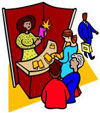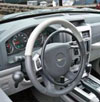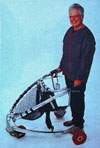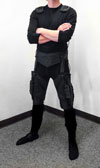| |
|
|

|
|
ATLAS |
|
|
Assistive
Technology
Laboratory
at
Stanford |
|
|
|
Technology
and design benefitting individuals with disabilities and older adults in the
local community |
February 17, 2015 |
|
|
|
|

Perspectives is the newsletter of the Stanford
course,
Perspectives in Assistive Technology.
This issue invites you to attend the course's assistive
technology faire.
Perspectives in Assistive
Technology is a Winter Quarter Stanford course in its ninth season
that explores the design, development, and use of assistive technology that
benefits people with disabilities and older adults. It consists of semi-weekly
classroom discussions; lectures by notable professionals,
clinicians, and assistive technology users; tours of local medical,
clinical, and engineering facilities; and an assistive technology faire.
Much more information can be found on the course
website.
|
Attend a lecture - You are invited to sit in on
class lectures that interest you. They are open
to the greater Stanford community - you need not be a Stanford student and
there is no required signup, enrollment, or charge. They will once again be
held on Tuesdays and Thursdays from 4:15 to 5:30pm in a large tiered,
accessible classroom on campus in the Thornton Center (Classroom 110) adjacent
to the Terman Fountain and near the Roble Gym, the same venue as last year.
Here are the parking options, maps, and
directions to the classroom. |
 |
|
Next class session - Thursday, February 19th
at 4:15pm:
|

|
Assistive Technology
Faire
|
|
Abstract: This
event will provide an opportunity for students and community members to get an
up-close look at a variety of devices and learn about available services. Users
of assistive technology products as well as small companies and agencies
serving individuals with disabilities and older adults are encouraged to bring
assistive technology devices to display, demonstrate, and
discuss. |
|

|
Visual Touch Therapy
Visual
Touch Therapy - Eric Medine
Visual Touch Therapy is a software program and game platform
that uses standard computer inputs, web-cams, and motion tracking devices as an
affordable, at-home therapy regimen for people with difficulty using their
motor skills, such as those with spinal cord injuries, head injuries, nerve
damage, or stroke patients. It features conventional video game challenges that
can be met by using repetitive movement exercises to provide a method of
therapy that (unlike exercise) is constantly rewarding, and gives more
immediate feedback than traditional methods. It also features a "patient
dashboard" that allows users to track in-game achievements, high scores, and a
ton of micro-rewards. This provides constant positive feedback and
encouragement every time they use their therapy regimen. |
|

|
Service Dog Training
Service Dog Tutor - Jean Cary and
Service Dog Ranger
Service Dog
Tutor adapts clients' own dogs to do specific service tasks for their
owners. Clients include seniors and children who have mobility and balance
challenges as well as cognitive disabilities. |
|

|
Digital Accelerator Ring and the
Main Hand Brake
Kempf -
Martine Kempf
The Digital
Accelerator Ring and the Main Hand Brake are hand controls that can be
installed on most cars with automatic transmissions to allow a person who has
lost the use of both legs to drive with both hands on the steering
wheel. |
|

|
Podna Rover
Podna
Designs - Elaine Levin
The Podna
Rover is an innovative all-terrain mobility device for individuals who need
additional support to maintain balance or stability while walking. The device
offers confidence to outdoor travelers over gravel, uneven surfaces, and
inclines. It features compliant wheels, a self-centering frame, a suspension to
soak up bumps, and self-locking brakes. |
|

|
Magnifiers, Mobility Aids,
Computer Hardware & Software
AT Exchange - Joe Escalante
The AT Exchange is a free service of the
AT Network that connects Californians to the
assistive technology devices they need to live independently. They provide new
and used low and high-tech devices for people with disabilities to
borrow. |
|

|
Beyond Exoskeletons - Wearable
Exosuit Technologies
SRI International - Roy Kornbluh
SRI is developing wearable "exosuits" that can
augment the musculoskeletal system for performance and strength enhancement and
assistance to overcome or prevent damage from injury or disease. SRI's exosuit
differs from exoskeletons by using new muscle-like actuation, comfortable and
soft skin attachment, and electronically releasable spring elements to minimize
mass, bulk, and noise. As part of DARPA's
Warrior
Web program, the technology is being applied to prevent and reduce
musculoskeletal injuries caused by dynamic events typically found in the
warfighter’s environment. We are exploring other military applications and
beginning to use the technologies to assist individuals with musculoskeletal
disease. |
|

|
Eyefluence’s Eye-interaction
Platform
Eyefluence - Peter Milford
Eyefluence’s
eye-interaction platform provides technology that can be integrated
into any head mounted device to realize the potential for wearable computing by
connecting your brain to the internet through your eyes. Head-mounted displays
equipped with Eyefluence's eye-interaction technology have the potential to
expand human intelligence, enhance social interaction, and revolutionize
entertainment. |
|

|
PEAT
BrainAid -
Richard Levinson & Sandy Gabrielli
PEAT helps
individuals with executive function disorders complete more real-world tasks,
improving their quality of life and independence. It is an smartphone or tablet
application that provides cueing and scheduling assistance for individuals with
memory, attention, and cognitive disorders. PEAT users include individuals with
traumatic brain injury, stroke, hypoxia, neurodegenerative conditions including
Autism, MS, Alzheimer’s disease, and attention deficit and hyperactivity
disorder (ADHD). PEAT employs NASA technology developed to provide executive
functions for autonomous rovers and is currently being used by veterans at the
VA Palo Alto Health Care System. |
|

|
Whill Wheelchair
Whill, Inc. -
Satashi Sugie
The Whill is an
omnidirectional four-wheel-drive mobility device meant to give wheelchair users
a sleek alternative to standard chairs, which many believe reinforce
stereotypes of weakness or helplessness. |
|

|
RoScooter and Rota
Wheel
RotaMobility - Chris Bayne and Daphne
Bayne
RotaMobility creates innovative
wheelchairs that users “row” - driving users to better health and
wellbeing. The RoScooter is a
manual lever propelled, geared scooter that provides exercise while traveling
at moderate speeds. The Rota Wheel is a lever propelled add-on that attaches to
the user's manual wheelchair to provide steering and propulsion using the same
mechanism as the RoScooter. |
|
Do you have a question or comment? - If you have
general questions, comments, or suggestions about the course, David L.
Jaffe, MS, the instructor, can be reached by
email or at 650/892-4464. Thank you
again for your interest.
Dave

To unsubscribe
from this newsletter, please email Dave. |
|















